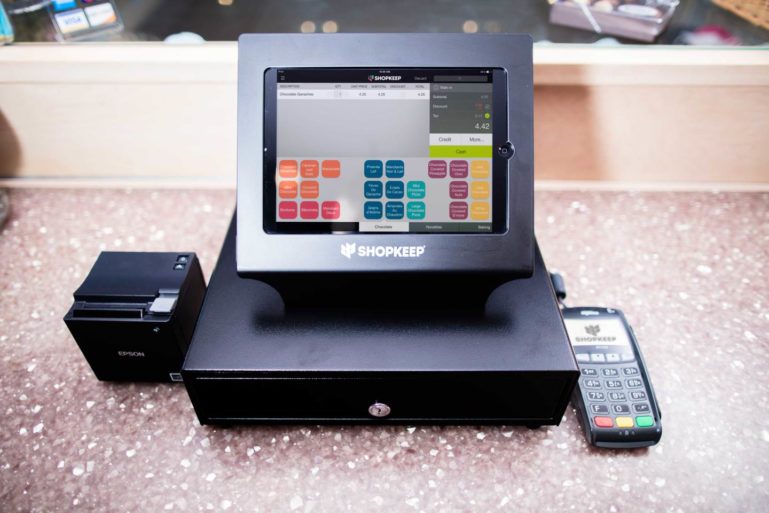
10 Signs You’ve Outgrown Your POS
As an entrepreneur at this stage of the game, you’re starting to see the pivotal role a Point of Sale (POS) system plays in your small business.
You’ve finally reached the tipping point. All the tell-tale signs are there – signs you’ve outgrown your POS. Business is booming, and all those funny little quirks and workarounds for day-to-day operational procedures aren’t so funny anymore.
What worked when you first opened your doors can’t keep up with the current demands of your business, and you’re contemplating a fresh start. However, it’s not uncommon for business owners to put off updating their POS system because of the perceived hassle of the whole process. And this perception often overshadows the actual benefits of a point of sale upgrade. If this sounds like you, you’re not alone.
Here’s a list of 10 signs you’ve outgrown your POS and it’s time for an upgrade.
After 38 years with the same program, we switched to Shopkeep and could not be happier. We are all older and were skeptical of learning a new system. The training was all we needed, and the system is so easy to operate. Highly recommend to anyone looking to simplify their Point of Sale
1. Operational Performance is Suffering
This is numero uno and one that’s most likely been slipping for some time. Is business increasing but from an operational standpoint you continue to fall further and further behind? Take a long, hard look at your business processes and identify areas where you can increase efficiency.
Is the checkout process taking longer than it should? Are customers able to pay with their preferred payment methods like credit cards, debit cards, and Apple Pay? How many hours does it take to conduct an inventory audit? Is your current system always on the fritz or do you have to perform some funny ritual to get it to work right?
When your operational performance suffers, you’ll also see a downward trend in customer satisfaction. That’s when all of these seemingly small things can have a significant effect on the performance of company operations and ultimately your bottom line.
2. Managing Inventory is a Nightmare
Speaking of bottom line, inventory management is a huge influence on your bottom dollar. Too much inventory can shrink your cash flow and not enough inventory can hurt your potential sales revenue. It’s a fine line all retailers walk. It’s an even finer line for restaurant owners because their inventory is perishable. At least retailers can sell end-of-season fashion on the discount rack to try and profit from unsold inventory; restaurateurs can’t offer expired food at a discount.
Do you spend too much time trying to track inventory on spreadsheets and not selling it? Are you part of the 46 percent of SMBs that use a manual tracking method or, gasp, don’t track inventory at all?
Here are some key inventory management features your POS software should have:
- The ability to organize products by department, category, and supplier (vendor)
- Functionality to set reorder triggers along with the recommended ordering amount
- Bulk inventory management so you can make product changes en masse
- The ability to attach raw goods to items so you can track the components that make up your basic inventory items.
The raw goods component of inventory management is a feature that’s mostly used in the restaurant industry to track the ingredients that make up a menu item. For example, if a burger is the menu item, the raw goods would be the lettuce and tomato that come with every burger sold. This helps to more accurately track food cost and inventory.
If your POS software doesn’t have the right inventory management features, you’re missing out on priceless amounts of data that can help you drive your business to the next level.
SEE ALSO: Basic Inventory Management Techniques for Better Business
3. Reporting is Inadequate
To truly understand how your business is performing, you need to have a powerful, real-time reporting suite for business intelligence
Sales reports will show you the departments and categories that are making you the most money. What items are you best sellers and what ones sit on the shelf for months? If you’re looking to expand or optimize your business, this information will help provide guidance and focus.
Here are some critical reports your POS solution should have:
- Sales by item, modifier, and variant
- Sales by department, category, and supplier
- Sales by employees and customers
- Sales by tender type (credit card, debit card, gift card, or EBT)
- Register reports such as a shift summary and pay-ins and payouts
- Inventory value report
- Inventory adjustment history
- A mobile reporting app like ShopKeep Pocket

4. A Lack of Integration with Other Business Management Tools
Because your point of sale system holds so much data and information on your inventory, your customers, and your financials, it’s essential that it also connects to some of your other business management solutions to help streamline the flow of data, so you can get more done in less time.
Let’s take a look a closer looks at a few core integrations:
An Accounting Software Package
Considering all the dollars and cents that exchange hands at the point of purchase, it only makes sense that your point of sale system should integrate with your accounting software. Small business accounting is a big administrative task that can quickly consume a significant amount of your time. Save hours by automatically sending register sales to your accounting program every night
An Ecommerce Platform
Is your brick-and-mortar store doing so well that you want to launch a webstore? Well, don’t even think about it if your POS isn’t integrated with your online store. Unless, of course, you want to live the retail nightmare we discussed in #2.
An Email Marketing Platform
A big part of customer loyalty is an email marketing platform. Email marketing has an average ROI of $38 for every $1 spent. So if you’re not regularly engaging your customers through email, you’re missing out on some serious dinero.
A Customer Loyalty Program
Customer loyalty programs are quickly becoming table stakes for businesses of any size. After all, it’s six to seven times more expensive to acquire a new customer with only a 5-20 percent probability of closing the sale; with existing customers, there’s a 60-70 percent selling probability. Rewarding customers with discounts or promotional products for their continued loyalty to your brand is a small price to pay to achieve your long-term goals.
Gift Card Support
It’s no secret that gift cards are a great marketing tool for any business. 72 percent of customers spend more than the value of their gift card and 93 percent of consumers will buy or receive a gift card. If your business doesn’t support gift cards, you’re missing out on some serious value.
5. Insufficient Payment Methods
Along the lines of gift card payments are other types of payment methods your business needs to accept. While almost all businesses accept cash by default, not all business accept electronic or digital transactions and those are quickly becoming the norm.
Here are a few others to include:
- Credit cards
- Debit cards
- Apple Pay
- EBT cards if applicable to your business
If your POS doesn’t support the above payment methods, it’s time to seriously consider an upgrade. Otherwise, you risk alienating shoppers and losing business.
6. No Employee Management Features
Unless you’re a solopreneur, chances are you have a few employees working for you. And if you do, you’ll need a POS solution that will give you a way to manage them. If you find yourself collecting pieces of scrap paper from staff with their weekly hours scribbled on it or tracking payroll by hours scheduled and not hours worked, your current POS isn’t doing its job.
- A respectable point of sale will provide you with the following:
- A way for employees to clock in and out of the system
- Be able to track employee labor up to the exact minute
- Assign levels of access by staff member
- In-depth shift reports so you can identify your top performers
7. It Doesn’t Support Multi-Store
Have you reached the point in your business where you finally have the resources to open a second, third or even 15th location? Are you ready to transcend from a small business and join the ranks of mid-size companies? If you are, you’ll need a POS system that can support multiple stores so you can easily manage all your locations.
Some features you’ll need are:
- A centralized back office management for all locations
- The ability to copy items and customers from one store to the next
- A way to report on each store individually as well as a whole company
8. Customer Support is Nonexistent or Poor at Best
The more stores you operate, the likelihood you’ll need to reach out to your POS provider’s customer support team is higher. There are more moving parts and people in the mix so the chances of an error occurring increases and you need someone you can depend on to get you through any issues that may arise.
A point of sale company that only offers email support or phone support during standard business hours just isn’t going to cut it. You need real people you can talk to any time of the day or night – and don’t accept anything less.
You need:
- 24/7/365 phone support
- Online chat for those simple questions that require an immediate answer
- Phone support when you have more complex issues you need to talk through
- Email support when you’re in a more passive mode
- Online documentation for the DIY’ers

9. A Lack of Mobility and Flexibility
Just as you want flexible customer service options, you also want your POS system to be flexible and mobile.These days, it’s all about flexibility and mobility. Business owners want options, and they want them to go. With a Mobile Point of Sale (mPOS), you can sell anywhere from pop-up shops to street fairs without compromising functionality. You can also use it in your store as a line-buster to move customers through the checkout process quicker.
Tablet-based point of sale solutions like ShopKeep’s iPad POS provides merchants with both of these critical features.
- Bluetooth barcode scanners to speed up transaction time
- Add another iPad register to line bust during peak seasonal periods
- Add more registers to test new markets with pop-up shops or community events
- Email or print receipts – whichever your customers prefer
10. It’s Contributing to a Negative Work-Life Balance
Lastly, we hope your small business is a labor of love. A passion that has inspired you to get to this point in your career. But what we don’t want is for your small business to take over your personal life and relationships.
46 percent of small business owners who say that work-life interferes with home life blame administrative tasks as the number one roadblock for achieving work-life balance. As you’ve learned from the previous nine tips, the right POS system can help you automate more than just your point of purchase process. It can streamline many of your core business processes and administrative tasks – giving you more time to spend with loved ones.
So there you have it. 10 signs you’ve outgrown your POS system. If any of them strike a chord with you, don’t ignore the warning signs. It’s time to upgrade your point of sale solution to one that will better serve your growing business.
Want to try ShopKeep for yourself?
Just answer a few easy questions.
Need help finding the right point of sale?
Just complete the form. We’ll call you right back to explain how ShopKeep can work for you.
Hit the ground running.Sprinting, in fact!
Read our free, comprehensive guide, Small Business 101, to learn all you need to know about starting a thriving business.

